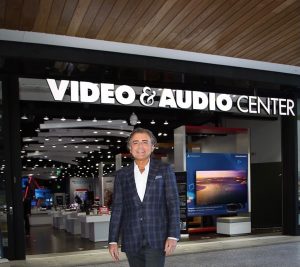How is the global chip supply shortage situation tracking relating to the major electronics and/or appliances product categories? Which categories are hardest hit?

David Pidgeon, CEO, Star-Power: “The situation is certainly getting better, as demand has eased in many categories. However, it seems like many different industries still have a high demand for chips, which will continue to cause shortages not just for our industry, but other industries as well. I feel we are going to continue to see shortages for at least the next year to two years, although we are seeing more availability on the electronic side. There seems to be improvement on the appliance side, but it has a long way to go before it is back to normal.”

Joseph Akhtarzad, Chairman, Video and Audio Center; President, Just One Touch: “We knew there were going to be shortages right at the beginning of Covid, so we went and got two additional warehouses for our Video and Audio Center and for our installation company, Just One Touch. We bought massive inventory in every category you can imagine, and we never had any shortages. We actually did amazing with our marketing efforts on radio, TV and even created a hotline to let people know we can come to their homes if they prefer not to come into the store.”

Robert Zohn, Founder and President, Value Electronics: “The SoC chip is the hardest to get, although things have eased up a lot. This chip is so important because it’s the video and audio processor that’s put into televisions and is the main brain that runs everything. It does all the functions from contrast control to rendering the picture and monitoring frame rate to audio processing and more. It just keeps getting more advanced every year, but that’s the category that’s also hit the hardest and it’s such an important product. Overall supply is much improved from the first few years of Covid.”
What is the most disruptive aspect of the chip supply situation (i.e. product supply, product pricing hikes)? When do you expect the situation to improve?
David Pidgeon, CEO, Star-Power: “I think it’s created a much easier avenue for manufacturers to increase prices where they normally would have been more resistant. Because of the shortages, it allows their suppliers to increase prices sometimes multiple times in the same year. If products were more available, I don’t think there would be near the amount of price increases that we’ve seen over the past two years.
The biggest disruption is when you can’t fulfill the complete package that the customer purchased. As a retailer we are being forced to take the product when it is available. Retailers are having to hold inventory that can’t be delivered, while waiting on the remaining pieces to arrive.
We are seeing some improvement on supply, but there is a long way to go to get back to normal times.”
Joseph Akhtarzad, Chairman, Video and Audio Center; President, Just One Touch:
“Obviously receivers, digital cameras, headphones, sound bars and mostly custom installation products were the hardest hit because of the shortage of chips in control systems. The chip manufacturers were using their produced chipsets for high ticket items. So basically, anything with a high ticket, I had the factory fulfill the orders. But it was not as easy for products like digital cameras, headphones or other devices. But right now, I think the factories are caught up and as you can see, prices are improving. And actually in most technology areas, the retail prices are coming down.”
Robert Zohn, Founder and President, Value Electronics: “Most chips come from mainland China, and there they are very strict still with Covid restrictions. People are not allowed to go to work and factories are closed down. They’re very limited in their production, because they’re concerned about the health of large groups of people being together in the same facility. But we are seeing change, like with Media Tech — one of the biggest companies that makes most of the chips for iPhones and TVs. They’re opening up a second manufacturing facility in Louisiana, which will help with American production and supply.
The price hikes — I haven’t seen as much as I’ve expected. The model year transition for televisions is every summer annually, so we’re just now seeing the new models. And the prices launched reasonably. But the competitors’ comparable products are a very big motivating factor, because they are so concerned with not being out of line with the price categories.”
Are you seeing any new shifts in consumer purchasing behaviors, both in the types of products they are now gravitating to, and in their choice of how to shop for them?
David Pidgeon, CEO, Star-Power: “During Covid, consumers were willing to buy any product you had in stock. As the supply is improving, customers are changing back to shopping and being able to choose and compare, so salespeople are now having to sell. It’s becoming a much more competitive environment.
In the luxury segment it seems the customer feels more inclined to see and listen to products to make an educated decision. I feel on the lower end of the product spectrum, the customer is more willing to order online without receiving an in-store experience. There is more of an inconsistency with consumers’ shopping patterns, as many are working from home, and they seem to have more flexibility to shop during the week rather than have to wait for the weekend.”

Joseph Akhtarzad, Chairman, Video and Audio Center; President, Just One Touch: “The TV became a method of two-way communication. More consumers wanted to buy smart TVs, where via the Internet they can stream movies, check traffic, weather or the stock market. Streaming became part of normal life for any household because of that, and today the TV is an essential communication device important in any household. It’s also not just regular TVs anymore; they are purchasing lifestyle TVs. Female acceptance throughout the house is important. They don’t want to see a black TV on the wall; they are buying more of the Frame or mirror TVs.
Obviously e-commerce and online is a huge factor. People came to trust shopping online, but most customers still want to feel and touch what they’re purchasing, especially if it’s a high-ticket item, has some new technologies or it’s a lifestyle look. On a weekly basis at our store, our salespeople get trained by manufacturers to know all the different features so they can describe them to the customers. More people are coming to stores so they can be taught how to use the TV, since it’s not just a TV anymore. They want to know how to navigate all the features that the TV has to offer them.”
Robert Zohn, Founder and President, Value Electronics: “I got into this business because my lifetime technical profession has been video and audio and TV broadcasting. My mission is to spread the good word of premium luxury audio and video, and because of the past few years, my initiative has boomed. People are now much more interested in premium audio and video to upgrade the entertainment in their homes. Consumers want to make upgrades in their homes as they are spending more time at home and want the best experience. The other category that has greatly increased is more reliable Wi-Fi, covering the whole house and the outside perimeter.
The online business is still a major growth area. While there’s more people coming into our showroom now, still people are not shopping as much physically in stores. But still email, phone and the website seem to be the major focus.”
Which aspects of the business booms that manifested themselves due to stay-at-home behaviors are continuing? Which do you think are not continuing?
David Pidgeon, CEO, Star-Power: “I think the biggest boom is to outdoor spaces, audio and electronics and appliances are all in high demand. People are spending a lot more time outside and at home, so now there is a higher demand for outdoor theaters and outdoor kitchens. We’re starting to see people going larger in their TVs, projection screens and spending more on sound systems and more robust kitchens. The outside is the perfect gathering place for everyone in the family.
I feel the home office is probably the biggest area that will show a decline. While during Covid everyone seemed to be working from home and wanting a new office, employers are starting to require personnel back in the office at least part time and will take away some of that demand.”
Joseph Akhtarzad, Chairman, Video and Audio Center; President, Just One Touch: “Consumers want a dedicated home theater; they don’t want to go to the movie theater as much as before. And since they’re staying home, they want to be able to stream movies and watch sports. So, we did a lot of dedicated movie theaters where a larger screen was the biggest factor. People were taking down smaller TVs and basically filling the wall. We quickly realized audio was a big part of that, since now people want to enjoy their TV with a bigger sound.”
Robert Zohn, Founder and President, Value Electronics: “Outdoor TVs and music/speakers throughout outside areas has to be the largest growth category. It always was a category that did okay for us because we’re niche specialists in this field. It’s not a giant market, but it has grown substantially from being very small to being moderately small. There is some emphasis on home offices, however we are not in the furniture/PC business.”
Looking at the future, what is your business shaping up to be in 2024?
David Pidgeon, CEO, Star-Power: “Starpower will continue to give our customers a luxury experience and build relationships. Consumers are realizing the ease of using technology and how it can simplify their lives. We’re very excited for our potential and positioning in the marketplace.”
Joseph Akhtarzad, Chairman, Video and Audio Center; President, Just One Touch: “We had a record-breaking year, year over year. The business is doing amazing due to awareness of the consumer, especially with our marketing. Where are we going? Still we’re going to their homes and helping build smart homes. Consumers are looking at their friends, family and neighbors and want to change their lifestyle as well. I think this will continue; people are realizing the importance of having entertainment around. Meanwhile we’re making sure that word of mouth is getting to their friends, and we just hired more salespeople and more technicians. When I see the smiles of customers or get a phone call saying how the family was together listening to music or watching TV, it makes me happy.”
Robert Zohn, Founder and President, Value Electronics: “We have a very narrow niche that we specialize in. It’s primarily limited to audio and video: televisions, projectors, video devices, Blu-ray players, speakers and all the other things that go with that. So that’s the only thing we do, unlike our competitors that might also do appliances or shades. I see continued growth for our company, and our core market focuses, which is premium, luxury audio and video. The market is growing, the product categories are growing, the consumer demand is growing, and we are focused on that.”
Is there anything specific we have not touched on that you’d care to comment on regarding business initiatives or strategies?
David Pidgeon, CEO, Star-Power: “Make sure you are communicating with your vendors and your customers. Relationships are the key to your success.”
Joseph Akhtarzad, Chairman, Video and Audio Center; President, Just One Touch: “We offer same-day delivery and setup, which is important to people today. They want to make sure if they purchase something, they can click it in when they go home. Our Video and Audio Center has been recognized as number one in the industry by the Hall of Fame. Video and Audio Center was the first to introduce the flat screen TV, first 4k TV, 8K and the first OLED TV, among others. So, Video and Audio Center was not just a regional story, but it became the launchpad for manufacturers to show off this new technology.”
Robert Zohn, Founder and President, Value Electronics: “There are new and very solid advancements for people that are upgrading to better quality systems and also larger screens. That’s a trend that’s happening. People are catching on to the recommended viewing distance to screen size, which suggests a larger screen size than most expect. And most people are shocked when I tell them what’s recommended by professionals: one and a half times the image height, which is a shockingly big screen. People are starting to embrace that and get larger TVs and better quality models. So, the manufacturers are responding by coming out with larger TVs, even 98-in. screens, although the 83-in. and 85-in. TVs are among the hottest sellers.”















